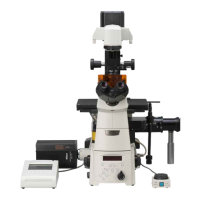
Do you have a question about the Nikon Eclipse Ti Series and is the answer not in the manual?
| Category | Microscope |
|---|---|
| Type | Inverted Microscope |
| Illumination | LED, Halogen, Metal halide |
| Focus | Motorized |
| Stage | Motorized |
| Automation | Yes |
| Focusing | Motorized |
| Nosepiece | Motorized |
| Software | Nikon NIS-Elements |
| Compatibility | Various accessories and peripherals |
Explains the Senarmont System and the need for correct combinations of objective, condenser, and DIC prisms.
Details combinations for ∞L, ∞M, ∞H, ∞SS condenser cassettes based on objective NA and condenser lens.
Refers to Table A for combinations of objectives, DIC prisms, and condenser cassettes for N1, N2, NR types.
Explains how to adjust contrast by rotating the polarizer and achieving sensitive gray background.
Explains how contrast is obtained in the shearing direction and how to align the specimen.
Details focusing and re-adjusting the field aperture diaphragm for high-magnification observation.
Describes the basic structure and how subjects cause phase changes in light.
Illustrates the light path through polarizers and Wollaston prisms in DIC microscopy.
Compares DIC and Phase Contrast microscopy characteristics, sensitivity, and suitability for specimens.
Guides the adjustment of polarizer and analyzer vibration direction for optimal contrast.
Details aligning the DIC polarizer's white index mark with the dial scale.
Guides aligning condenser and polarizer to achieve a dark cross in the objective's exit pupil.
Lists causes and countermeasures for lack of contrast in DIC method.
Lists causes and countermeasures for poor viewing or contrast issues.